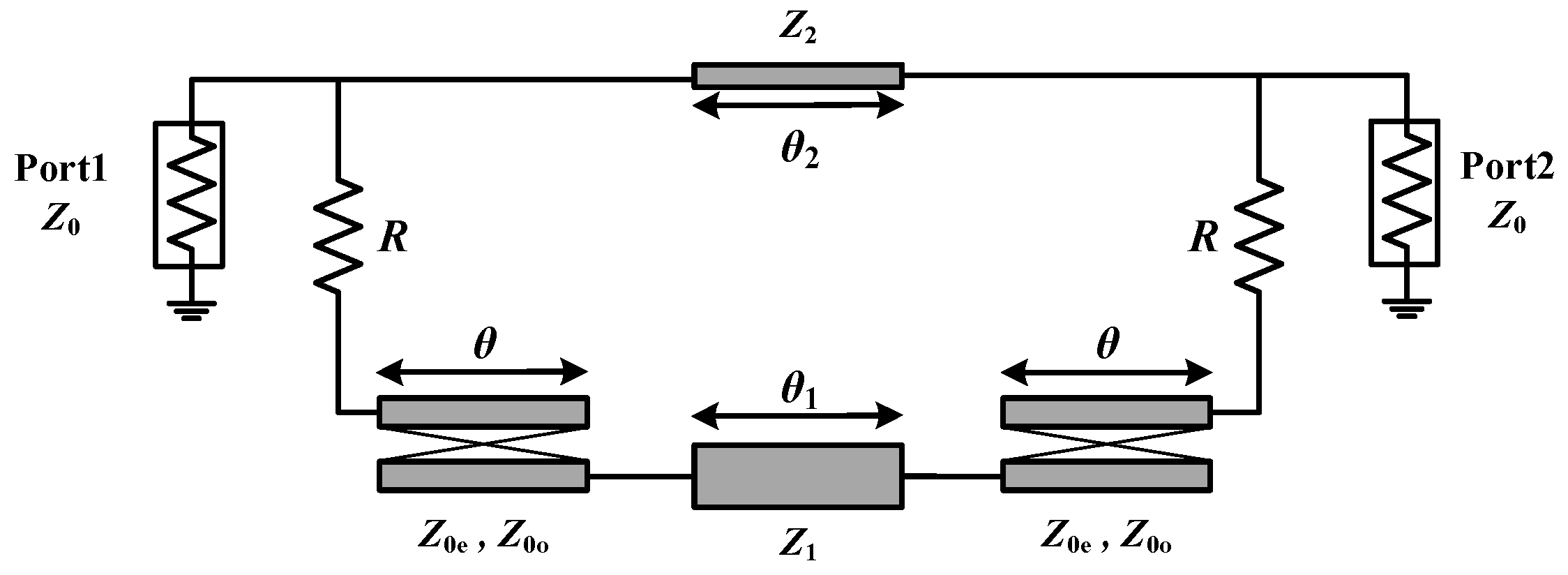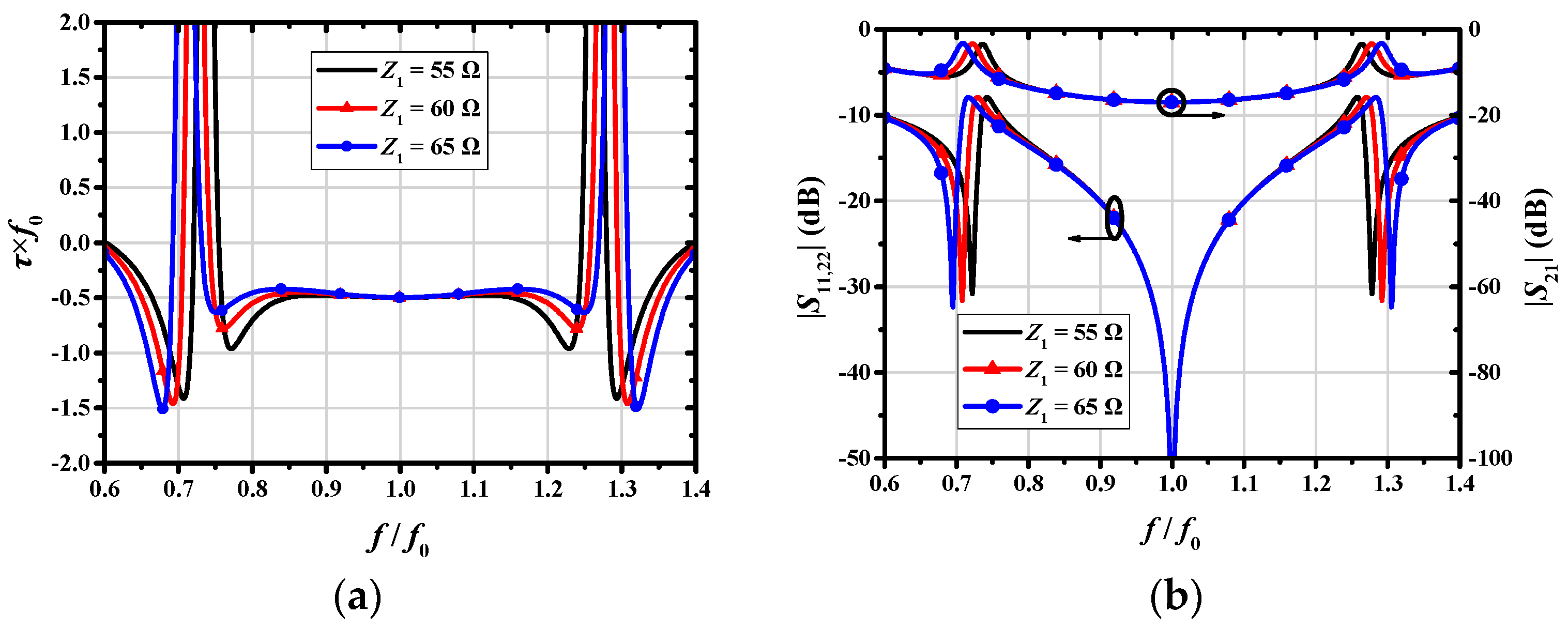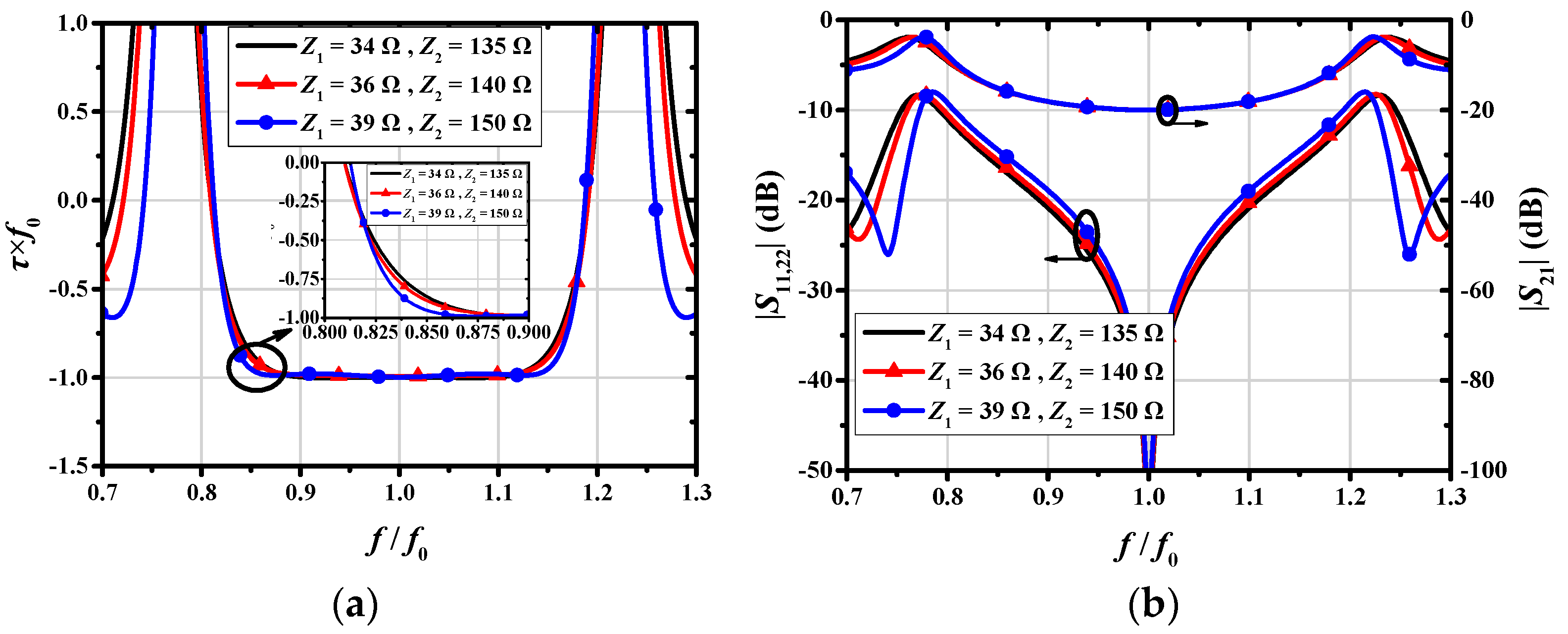Compact Broadband Negative Group Delay Circuit with Flatness and Bandwidth Enhancement
Abstract
:1. Introduction
2. Circuit Structure and Design Theory
2.1. Even- and Odd-Mode Analysis
2.2. S-Parameters and NGD Analysis
2.3. Free Variables Analysis
3. Experimental Verification
4. Conclusions
Author Contributions
Funding
Data Availability Statement
Conflicts of Interest
References
- Ahn, K.-P.; Ishikawa, R.; Honjo, K. Low noise group delay equalization technique for UWB InGaP/GaAs HBT LNA. IEEE Microw. Wirel. Components Lett. 2010, 20, 405–407. [Google Scholar] [CrossRef]
- Mirzaei, H.; Eleftheriades, G.V. Arbitrary-angle squint-free beamforming in series-fed antenna arrays using non-Foster elements synthesized by negative-group-delay networks. IEEE Trans. Antennas Propag. 2015, 63, 1997–2010. [Google Scholar] [CrossRef]
- Baloglu, O.; Cicekoglu, O.; Herencsar, N. Single CFOA-based active Negative Group Delay circuits for signal anticipation. Eng. Sci. Technol. Int. J. 2023, 48, 101590. [Google Scholar] [CrossRef]
- Ravelo, B.; Wan, F.; Nebhen, J.; Rahajandraibe, W.; Lalléchère, S. Resonance effect reduction with bandpass negative group delay fully passive function. IEEE Trans. Circuits Syst. II Express Briefs 2021, 68, 2364–2368. [Google Scholar] [CrossRef]
- Yuan, A.; Fang, S.; Wang, Z.; Liu, H. A Novel Multifunctional Negative Group Delay Circuit for Realizing Band-Pass, High-Pass and Low-Pass. Electronics 2021, 10, 1742. [Google Scholar] [CrossRef]
- Nako, J.; Psychalinos, C.; Elwakil, A.; Maundy, B. Power-Law Negative Group Delay Filters. Electronics 2024, 13, 522. [Google Scholar] [CrossRef]
- Mirzaei, H.; Eleftheriades, G.V. Realizing non-Foster reactive elements using negative-group-delay networks. IEEE Trans. Microw. Theory Tech. 2013, 61, 4322–4332. [Google Scholar] [CrossRef]
- Zhang, T.; Yang, T. A novel fully reconfigurable non foster capacitance using distributed negative group delay networks. IEEE Access 2019, 7, 92768–92777. [Google Scholar] [CrossRef]
- Wan, F.; Miao, X.; Ravelo, B.; Yuan, Q.; Cheng, J.; Ji, Q.; Ge, J. Design of multi-scale negative group delay circuit for sensors signal time-delay cancellation. IEEE Sens. J. 2019, 19, 8951–8962. [Google Scholar] [CrossRef]
- Ravelo, B.; Wan, F.; Ge, J. Anticipating actuator arbitrary action with a low-pass negative group delay function. IEEE Trans. Ind. Electron. 2021, 68, 694–702. [Google Scholar] [CrossRef]
- Chaudhary, G.; Jeong, Y.; Lim, J. Microstrip line negative group delay filters for microwave circuits. IEEE Trans. Microw. Theory Tech. 2014, 62, 234–243. [Google Scholar] [CrossRef]
- Wang, Z.; Cao, Y.; Shao, T.; Fang, S.; Liu, Y. A negative group delay microwave circuit based on signal interference techniques. IEEE Microw. Wirel. Components Lett. 2018, 28, 290–292. [Google Scholar] [CrossRef]
- Ravelo, B.; Wan, F.; Li, N.; Xu, Z.; Thakur, P.; Thakur, A. Diakoptics modelling applied to flying bird-shape NGD microstrip circuit. IEEE Trans. Circuits Syst. II Express Briefs 2021, 68, 637–641. [Google Scholar] [CrossRef]
- Liu, Z.; Zhang, J.; Lei, X.; Gao, J.; Xu, Z.; Li, T. Negative Group Delay Metamaterials Based on Split-Ring Resonators and Their Application. Electronics 2023, 12, 1064. [Google Scholar] [CrossRef]
- Ravelo, B.; Le Roy, M.; Perennec, A. Application of negative group delay active circuits to the design of broadband and constant phase shifters. Microw. Opt. Technol. Lett. 2008, 50, 3078–3080. [Google Scholar] [CrossRef]
- Qiu, L.; Wu, L.; Yin, W.; Mao, J. A filter with equal-ripple negative group delay. In Proceedings of the 2018 IEEE Radio and Wireless Symposium, Anaheim, CA, USA, 15–18 January 2018. [Google Scholar]
- Shao, T.; Fang, S.; Wang, Z.; Liu, H. A compact dual-band negative group delay microwave circuit. Radioengineering 2018, 27, 1070–1076. [Google Scholar] [CrossRef]
- Wu, Y.; Wang, H.; Zhuang, Z.; Liu, Y.; Xue, Q.; Kishk, A.A. A novel arbitrary terminated unequal coupler with bandwidth-enhanced positive and negative group delay characteristics. IEEE Trans. Microw. Theory Tech. 2018, 66, 2170–2184. [Google Scholar] [CrossRef]
- Wang, H.; Wu, Y.; Wu, Z.; Wang, W.; Liu, Y. Compact arbitrary terminated power divider with bandwidth-enhanced negative group delay characteristics. Int. J. Circuit Theory Appl. 2019, 47, 909–916. [Google Scholar] [CrossRef]
- Chaudhary, G.; Jeong, Y. Arbitrary terminated negative group delay circuit using signal interference concept. Int. J. RF Microw. Comput. Aided Eng. 2020, 30, e22341. [Google Scholar] [CrossRef]
- Meng, Y.; Wang, Z.; Fang, S.; Shao, T.; Liu, H.; Chen, Z. Group delay flatness and bandwidth enhancement of wideband negative group delay microwave circuit. Int. J. RF Microw. Comput. Aided Eng. 2020, 30, e22443. [Google Scholar] [CrossRef]
- Wang, Z.; Meng, Y.; Fang, S.; Liu, H. Wideband flat negative group delay circuit with improved signal attenuation. IEEE Trans. Circuits Syst. II Express Briefs 2022, 69, 3371–3375. [Google Scholar] [CrossRef]
- Gu, T.; Wan, F.; Chen, J.; Ravelo, B.; Zhao, X. Compact and wideband flat negative group delay circuit investigation. IEEE Trans. Circuits Syst. II Express Briefs 2023, 70, 1916–1920. [Google Scholar] [CrossRef]
- Zheng, Y.; Wang, W.; Wu, Y. Planar coupled-line-based flat negative group delay microwave circuit with size reduced and bandwidth enhanced. IEEE Trans. Circuits Syst. II Express Briefs 2023, 70, 4339–4343. [Google Scholar] [CrossRef]
- Hee-Ran, A. Asymmetric Passive Components in Microwave Integrated Circuits, 1st ed.; John Wiley & Sons: Hoboken, NJ, USA, 2006; pp. 66–77. [Google Scholar]









| Refs. | f0 (GHz) | NGD (ns) | GD Ripple (%) | Flat-NGD Bandwidth (%) | IL (dB) | Size (λg × λg) | FOM1/FOM2 (×10−3) |
|---|---|---|---|---|---|---|---|
| [18] | 2.14 | −0.49 | 16 | 14.7 | 16.6 | 0.73 × 1.01 | 23.2/21.5 |
| [19] | 2.14 | −0.20 | 40 | 9.30 | 14.0 | 0.68 × 0.41 | 8.0/28.7 |
| [20] | 2.00 | −0.88 | 25 | 9.50 | 33.1 | 0.41× 0.51 | 3.7/17.7 |
| [21] | 1.00 | −0.50 | 16 | 46.3 | 18.8 | 0.24 × 0.34 | 26.4/325.9 |
| [22] | 2.14 | −1.11 | 23 | 6.10 | 9.75 | 0.65 × 1.18 | 46.9/61.1 |
| [23] | 0.68 | −0.49 | 10 | 31.8 | 15.3 | 0.20 × 0.38 | 26.8/352.2 |
| [24] | 0.94 | −0.54 | 14 | 35.0 | 18.3 | 0.09 × 0.48 | 21.6/501.4 |
| This Work | 1.00 | −0.48 | 19 | 50.9 | 18.0 | 0.14 × 0.29 | 30.8/757.6 |
Disclaimer/Publisher’s Note: The statements, opinions and data contained in all publications are solely those of the individual author(s) and contributor(s) and not of MDPI and/or the editor(s). MDPI and/or the editor(s) disclaim responsibility for any injury to people or property resulting from any ideas, methods, instructions or products referred to in the content. |
© 2024 by the authors. Licensee MDPI, Basel, Switzerland. This article is an open access article distributed under the terms and conditions of the Creative Commons Attribution (CC BY) license (https://creativecommons.org/licenses/by/4.0/).
Share and Cite
Meng, Y.; Li, P.; Yuan, A.; Lan, Z. Compact Broadband Negative Group Delay Circuit with Flatness and Bandwidth Enhancement. Electronics 2024, 13, 3056. https://doi.org/10.3390/electronics13153056
Meng Y, Li P, Yuan A, Lan Z. Compact Broadband Negative Group Delay Circuit with Flatness and Bandwidth Enhancement. Electronics. 2024; 13(15):3056. https://doi.org/10.3390/electronics13153056
Chicago/Turabian StyleMeng, Yuwei, Peng Li, Aixia Yuan, and Zhenping Lan. 2024. "Compact Broadband Negative Group Delay Circuit with Flatness and Bandwidth Enhancement" Electronics 13, no. 15: 3056. https://doi.org/10.3390/electronics13153056






